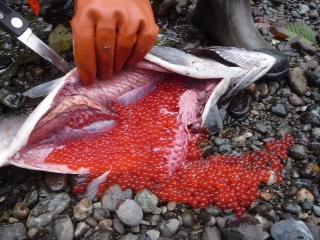Save the salmon – what you can do to help
A volunteer examines the contents of a dead salmon from Miller Creek. Many salmon are dying from pollutants in the creek before they can spawn.
Tue, 04/18/2017
By Lindsay Peyton
There’s something fishy going on in Miller and Walker Creeks.
The waterways wind through Burien, Normandy Park and SeaTac – and adult salmon use them as a place to spawn eggs. Younger salmon use the creeks as aquatic highways, traversing the paths to Puget Sound.
But each year, a number of fish are dying before they are able to spawn. Volunteers are keeping count of how many salmon suffer from “pre-spawn mortality.”
The City of Burien and King County teamed up to present the findings from the most recent “Community Salmon Investigation” in the Highline area to residents on Thursday, April 6 at the Burien Community Center.
Elissa Ostergaard, King County basin steward of Miller and Walker Creeks, said 31 volunteer citizen scientists spent months in 2016 counting the salmon in various locations on the creeks.
In total, they reported seeing 294 live fish. There were 68 dead coho and 43 dead chum counted – and most were found in Miller Creek.
While there are a number of challenges to the salmon populations – like wildlife predators and winter floods that can wash eggs downstream, Ostergaard said chemical contaminants cause most of the deaths.
She explained that salmon are dying from pollution that enters the creeks – and about 60 percent of cohos are dying before they have a chance to spawn.
“There’s a lot of roads and development, and downtown Burien is right in the middle,” she said. “We’ve built a lot of infrastructure to keep the water from flooding. The thing is when the water goes into the gutters, it’s not treated.”
When water hits dirt and grass, it is naturally filtered before hitting the creek, she said. When rain goes directly from the roads, sidewalks and driveways, however, it carries with it oil, grease, chemicals, fertilizers, soapsuds and rubber from tires.
Ostergaard said that the National Oceanic and Atmospheric Administration tested the effects of highway runoff on adult coho salmon, placing the fish in tubes containing the polluted water.
“Those fish were all dead in four hours,” she said. “They filtered the same water, put adult coho in tubes and the fish were still alive days after.”
She hopes to see higher numbers of salmon in the creeks – and fewer dead fish.
“With our habits and our pollution, we might need to do a little work to make it better,” she said.
Mary Eidmann, Burien’s stormwater outreach specialist, agrees that residents can help mitigate the problem by changing a few habits.
She recommends building rain gardens and following guidelines for low impact developments.
Eidmann said a regional program “Don’t Drip and Drive” encourages drivers to fix leaks in the cars.
“All the oil that leaks from cars just goes straight into the water,” she said.
Participating auto shops in the program in Burien are offering free leak checks and 25 percent off repairs up to $50.
Eidmann also asks residents to try organic and natural gardening practices – and refrain from using pesticides and fertilizers.
“And don’t wash your car in the driveway,” she said.
Ostergaard is also looking for volunteers to sign up this year to count salmon. She said crews also gather to remove English Ivy, which is a major threat to the creek system.
For more information on how to volunteer, visit www.kingcounty.gov/services/environment/watersheds/central-puget-sound/…
For more information about Burien’s stormwater outreach efforts, visit http://www.burienwa.gov/waterschool.


